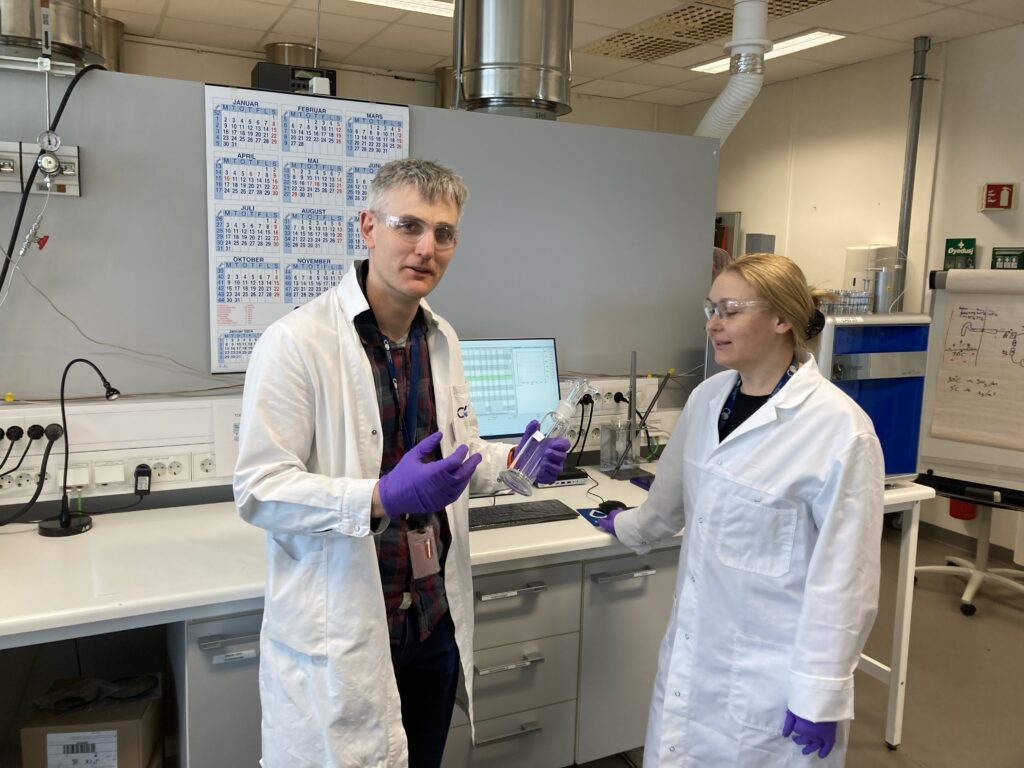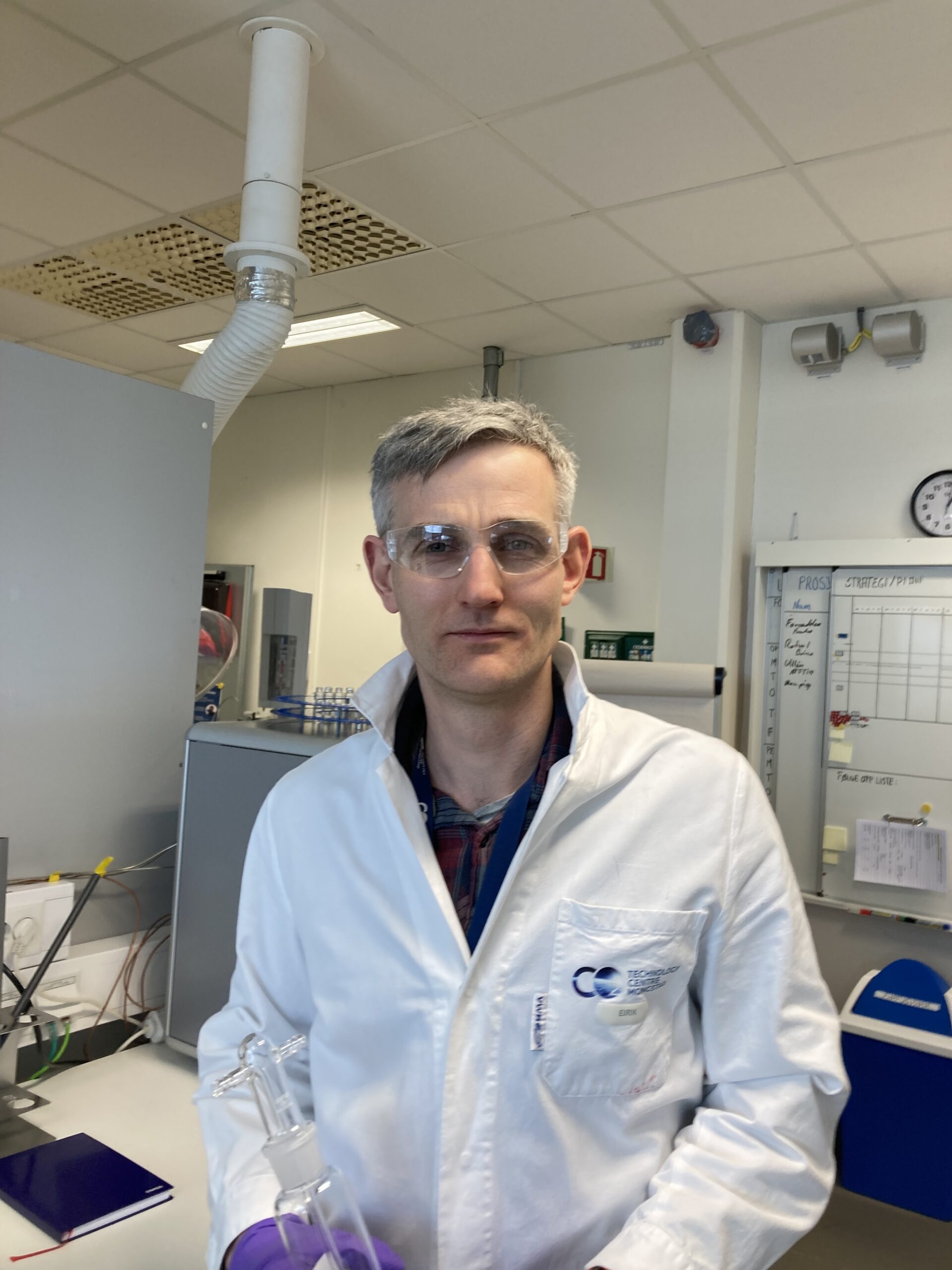15.03.2023
“We have a world-class quality system”
Eirik Romslo Kleppe joined TCM nine years ago and has been an important driver behind sampling and analysis work related to testing campaigns at the facility. “We have developed a high-quality system that maintains a very high standard – I would say it’s world class!”
Very soon Kleppe will be moving on to new and exciting challenges in a new role with Equinor at Sandsli in Bergen.
“How did you first get interested in CO2 capture?”
“It was a bit random. I had a really great job with a company in Stavanger that supplies laboratory services to a range of customers in oil and gas, as well as in other industries. This was where I first got to grips with sampling and analyses, including in connection with test drilling and refining. However, my family were keen to return to the Bergen area, and I spotted the TCM laboratory vacancy and figured it was an interesting opportunity. Working on CO2 capture broke new ground for me in my career and represented an exciting opportunity. I don’t regret making that move one bit.”
“Tell us about your first encounter with TCM?”
“Back in my student days, I had a part-time job working on the quayside at the refinery next door, and from there I was able to track construction of TCM on the adjacent site. But what first struck me when I started working at TCM was not only that the facility is huge, but that it’s also extremely important in winning the fight against climate change. I also noticed that my colleagues were very down-to-earth and felt a great sense of responsibility in relation to the task we are assigned with. There’s a really good atmosphere here.”

Facts
Name: Eirik Romslo Kleppe
Age: 41
Education: Bachelor’s degree in Computer Engineering (Bergen University College) and Bachelor’s degree in Chemistry (University of Bergen)
Marital status: Married with three children
Affiliation to TCM: Senior Laboratory Engineer, May 2014 – April 2023, hired.

“How would you describe your role as Senior Laboratory Engineer?”
“My task has mainly been to take samples in connection with test campaigns and analyse them in the lab – my primary focus has been on emissions. A lot of people think of me as the guy who flies up and down the absorber a lot, but it’s actually my lab work that has required the most time and effort. In the early days, there was no framework for this type of work, so we had to develop hood methods ourselves and document these in the best possible way. Based on the experiences we gained over time, we have established and developed a high-quality system that maintains a very high standard – I would say it’s world class!”
“What’s the most rewarding and interesting work you have done at TCM?”
“Developing methods and continuously making improvements in them is never a one man show. What is particularly exciting and rewarding at TCM is the way people hailing from different professional backgrounds – engineers, academics and skilled workers – come together to discuss and solve various challenges through both a proactive approach and an understanding of what happens in the capture facility during our various tests. This teamwork is absolutely essential to be able to provide technology suppliers with accurate data, as well as for the spread of knowledge from open test campaigns that appear in TCM’s many publications.”
“What would you say has been particularly demanding about your sampling and analysis work?”
“Funny you should ask! You won’t be surprised to hear that the weather gods aren’t particularly accommodating at Mongstad, so sampling work can be very physically demanding. Besides that, situations arise from time to time where customers don’t get the results they wanted or envisioned. When that happens, we have to provide good explanations as to why, which can sometimes entail further tests to underpin our professional approach. You have to be able to tolerate disagreement and discussion, while maintaining an open and professional approach to whatever it is that is difficult or problematic. All that being said, things usually go well!”
“Looking back to TCM’s beginnings in 2012, what do people who used to work at TCM or still do have reason to be proud of?”
“The short and simple answer is that for technology suppliers worldwide it has become a necessary mark of quality to have tested at TCM before introducing their technology to the CCS market. Everyone has confidence in the reliability of our test results.”
“Capturing CO2 is considered to be the most technically complicated and demanding part of the CCS process. In Norway, two capture facilities are now being built: one at Brevik and one at Klemetsrud in Oslo. Have you thought about how TCM can help these projects succeed?”
“Longship is incredibly exciting, and it says a lot about the technology suppliers for the two CCS projects, Aker Carbon Capture and Shell Cansolv respectively, that both have run test campaigns at TCM. The extensive expertise on hand at TCM will be useful when the facilities are commissioned, among other things with regard to measuring and making visible the energy costs that come with CO2 capture on a full scale.”
“TCM have solved several challenges related to amine technology by MEA campaigns, for example amine aerosol emissions, continuous measurements of amine to air, etc. What other technical topics do you think are still lacking testing and good solutions, and how can TCM play an important role in this?”
“There is still much to address, including what happens when flue gas enters a capture facility. The challenge is to ensure that the solvent remains in as good a state as possible for as long as possible. It isn’t only of great importance in terms of the costs associated with CO2 capture but also environmentally. TCM’s expertise undoubtedly has an important role to play.”
“What’s your wish for TCM in the years to come?”
“Over the nine years I have spent at TCM, the team has shown an impressive ability and willingness to develop and change. This has been necessary, both because customers’ demands and expectations have increased, and because the financial framework conditions for the operation have become tighter. My wish and hope is that TCM will continue to have a place in the CCS industry and remain relevant to stakeholders both nationally and internationally. The industry’s task is to help ensure that the green transition is as affordable as possible. For TCM, this means being the driving force in the work to reduce costs when capturing CO2.”
